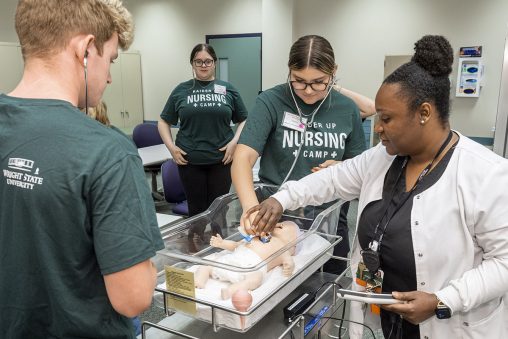
Wright State received $1,443,000 in funding from the Ohio Department of Higher Education to expand its capacity to prepare students for in-demand jobs in nursing, advanced engineering, manufacturing and robotics at the Dayton and Lake campuses.
New equipment is coming to Wright State University’s Dayton and Lake campuses to prepare students for careers in nursing, robotics and manufacturing.
Wright State received a state workforce development award to expand its capacity to prepare students for in-demand jobs related to health care, advanced engineering and manufacturing.
The funds will support in-class activities and enhance students’ classroom experiences at Wright State’s Dayton and Lake campuses, which offer nursing and engineering programs.
“Wright State is a place where we’re big enough to have really nice equipment and small enough that our students actually get to touch it,” said Darryl Ahner, Ph.D., dean of Wright State’s College of Engineering and Computer Science.
Wright State’s Digital Engineering Technology and Health Care Workforce Development project is supported by a $1.44 million grant from the Ohio Department of Higher Education as part of its Super RAPIDS regional program. The RAPIDS program is designed to strengthen education and training opportunities that maximize workforce development efforts in the state.
“The RAPIDS grant funding will allow the Lake Campus to significantly upgrade our equipment, bringing it more in line with industry standards used by businesses and hospitals in West Central Ohio,” said Andrea Faber, Ph.D., vice provost and chief administrative officer of the Lake Campus. “This new equipment will give the Lake Campus students invaluable hands-on experience with these in-demand technologies.”
The primary objective of Wright State’s workforce development project is to equip the region’s workforce with state-of-the-art technology, training resources and simulation tools so that students are workforce-ready when they graduate.
“It continues to allow our students to be on the leading edge of technology as we’re moving into the 21st century,” Ahner said.
Wright State’s School of Nursing will use its portion of the state funds to improve patient care and safety by enhancing training opportunities for nursing students.
Nursing students at the Dayton and Lake campuses will learn to use automated medication dispensing units ensuring safe medication administration. The units help ensure the nurse has the correct medication and dosage at the right time for the right patient.
The students will learn to operate the same equipment used by Wright State’s academic practice partners, including Premier Health, where many Wright State nursing graduates are employed. Practicing to operate the automated medication dispensing equipment in the laboratory setting will assist students in the clinical setting and role transition after graduation.
“The continued introduction and exposure of new technology to nursing students is vital in their education to build the necessary skills to become confident nurses,” said Marlene Stuber, clinical assistant professor and director of simulation.
Wright State will also purchase simulators on which students can continue strengthening their nursing skills.
The Lake Campus will receive its first life-like infant simulator to give students hands-on experience caring for newborn and infant patient populations.
Nursing students at the Dayton and Lake campuses will practice therapeutic communication techniques with new life-like human communication simulators.
The simulators use artificial intelligence to verbally respond to students’ spoken inquiries and generate a transcript of interactions that can be reviewed later. Students can also review video recordings of nonverbal communication mannerisms captured through the simulators’ eyes.
“The simulators will provide an invaluable safe and effective tool for competency-based education in patient therapeutic communication, physical assessment and technical nursing skills,” Stuber said.
Engineering students will be trained on new robotics equipment, virtual welder devices, electrical vehicle simulators, 3D scanning and digital engineering technology.
The new robotics equipment will allow the College of Engineering and Computer Science and the Lake Campus’ engineering program to take their manufacturing programs to the next level, Ahner said.
“It’s equipment you’d find in industry that the students can work on here before they go out into the workforce,” he said.

 Wright State Police Department delivers major donation to Raider Food Pantry
Wright State Police Department delivers major donation to Raider Food Pantry  Wright State engineering and computer science students earn prestigious federal SMART Scholarships
Wright State engineering and computer science students earn prestigious federal SMART Scholarships  Wright State Police Chief Kurt Holden selected for prestigious FBI National Academy program
Wright State Police Chief Kurt Holden selected for prestigious FBI National Academy program  Wright State’s Raj Soin College of Business ranked among the best for entrepreneurs by Princeton Review
Wright State’s Raj Soin College of Business ranked among the best for entrepreneurs by Princeton Review  Wright State’s annual Raidersgiving draws hundreds
Wright State’s annual Raidersgiving draws hundreds 